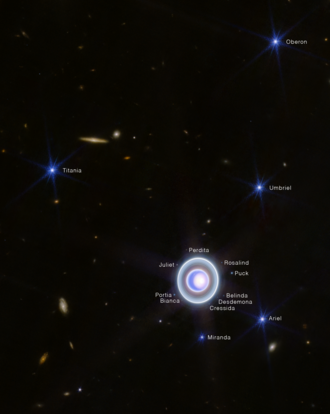
Back Uranus se natuurlike satelliete Afrikaans أقمار أورانوس Arabic Satélites d'Uranu AST Uranın peykləri Azerbaijani اورانوس قمرلری AZB Listn vo de Uranusmond BAR Спадарожнікі Урана Byelorussian Спадарожнікі Ўрана BE-X-OLD Естествени спътници на Уран Bulgarian ইউরেনাসের প্রাকৃতিক উপগ্রহ Bengali/Bangla

Uranus, the seventh planet of the Solar System, has 28 confirmed moons. The 27 with names are named after characters that appear in, or are mentioned in, William Shakespeare's plays and Alexander Pope's poem The Rape of the Lock.[1] Uranus's moons are divided into three groups: thirteen inner moons, five major moons, and ten irregular moons. The inner and major moons all have prograde orbits and are cumulatively classified as regular moons. In contrast, the orbits of the irregular moons are distant, highly inclined, and mostly retrograde.
The inner moons are small dark bodies that share common properties and origins with Uranus's rings. The five major moons are ellipsoidal, indicating that they reached hydrostatic equilibrium at some point in their past (and may still be in equilibrium), and four of them show signs of internally driven processes such as canyon formation and volcanism on their surfaces.[2] The largest of these five, Titania, is 1,578 km in diameter and the eighth-largest moon in the Solar System, about one-twentieth the mass of the Earth's Moon. The orbits of the regular moons are nearly coplanar with Uranus's equator, which is tilted 97.77° to its orbit. Uranus's irregular moons have elliptical and strongly inclined (mostly retrograde) orbits at large distances from the planet.[3]
William Herschel discovered the first two moons, Titania and Oberon, in 1787. The other three ellipsoidal moons were discovered in 1851 by William Lassell (Ariel and Umbriel) and in 1948 by Gerard Kuiper (Miranda).[1] These five may be in hydrostatic equilibrium. The remaining moons were discovered after 1985, either during the Voyager 2 flyby mission or with the aid of advanced Earth-based telescopes.[2][3]
- ^ a b Cite error: The named reference
Gazetteerwas invoked but never defined (see the help page). - ^ a b Cite error: The named reference
Smith Soderblom et al. 1986was invoked but never defined (see the help page). - ^ a b Cite error: The named reference
Sheppard2005was invoked but never defined (see the help page).